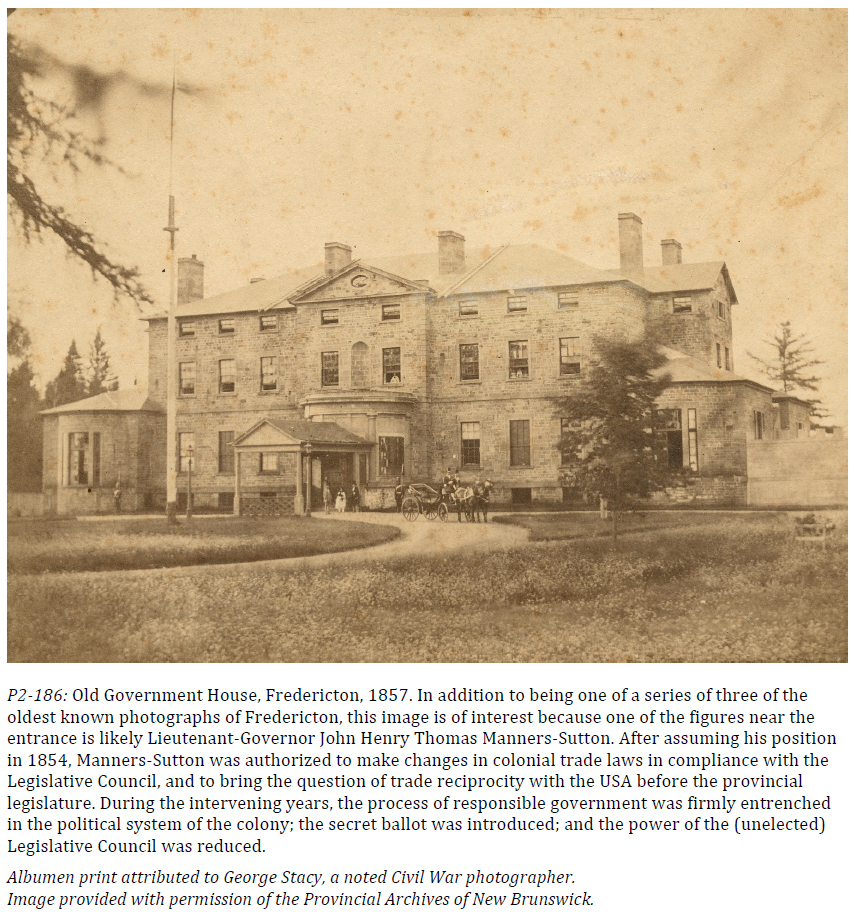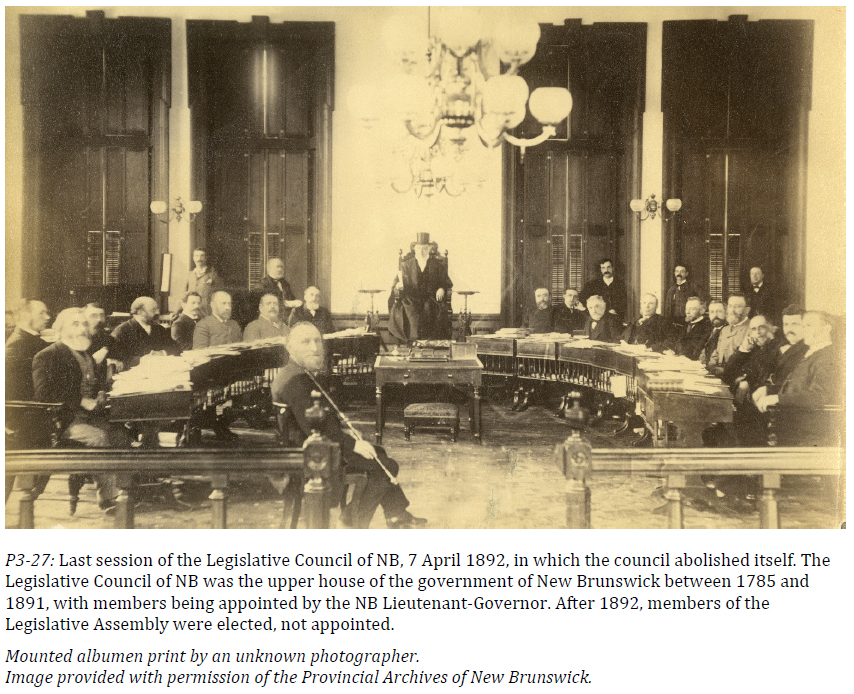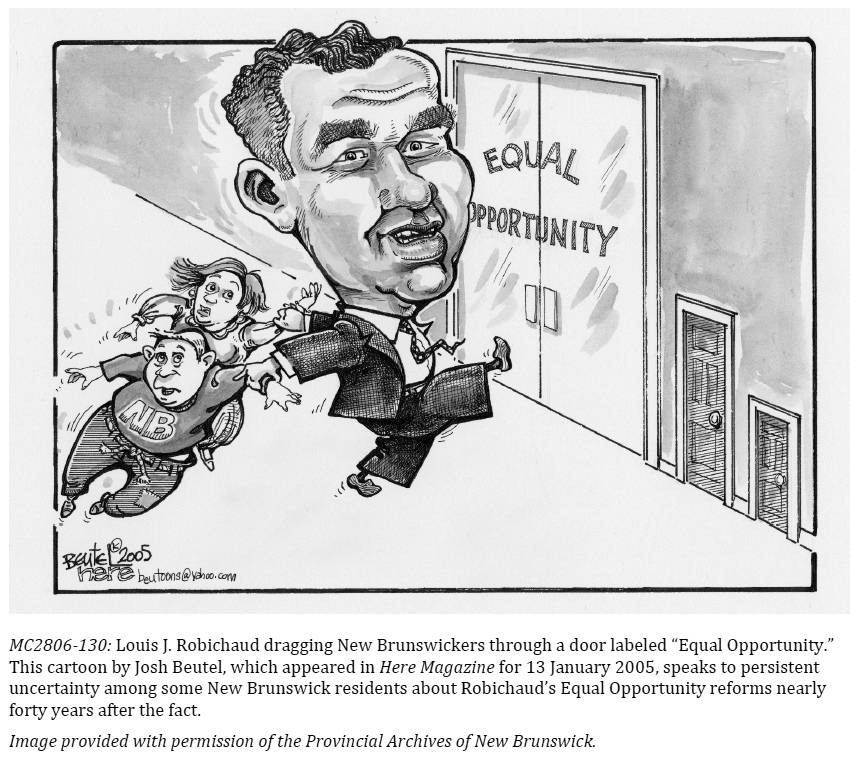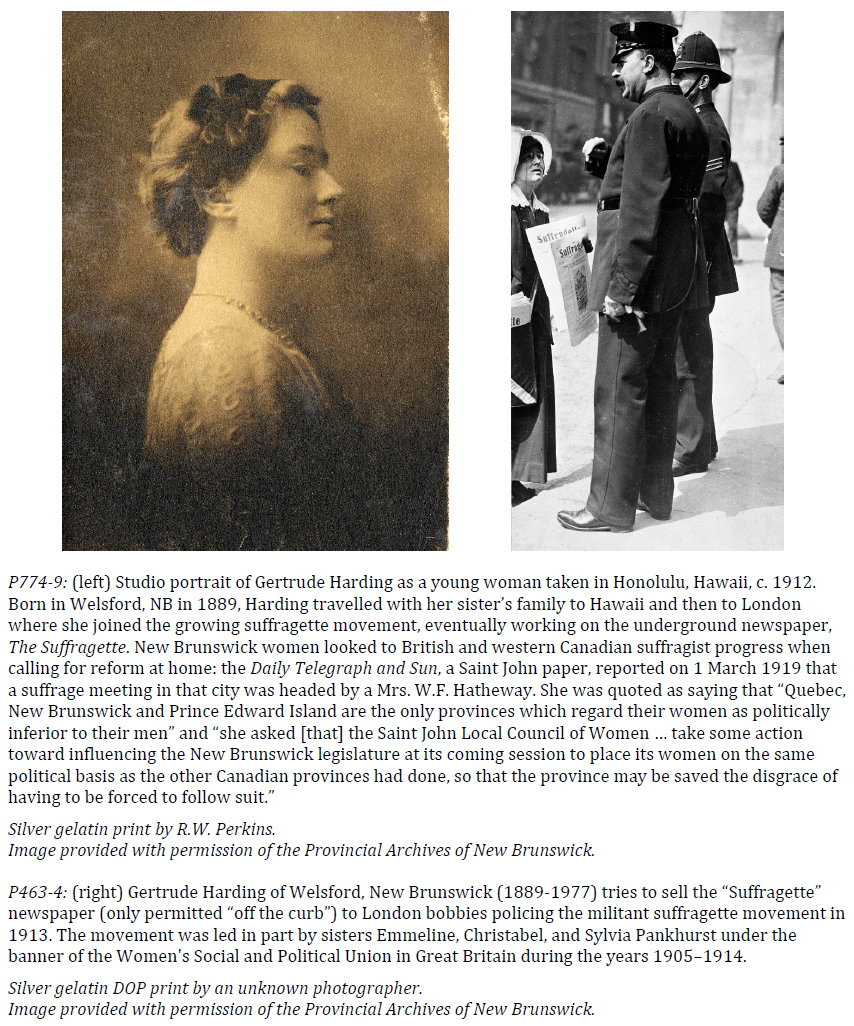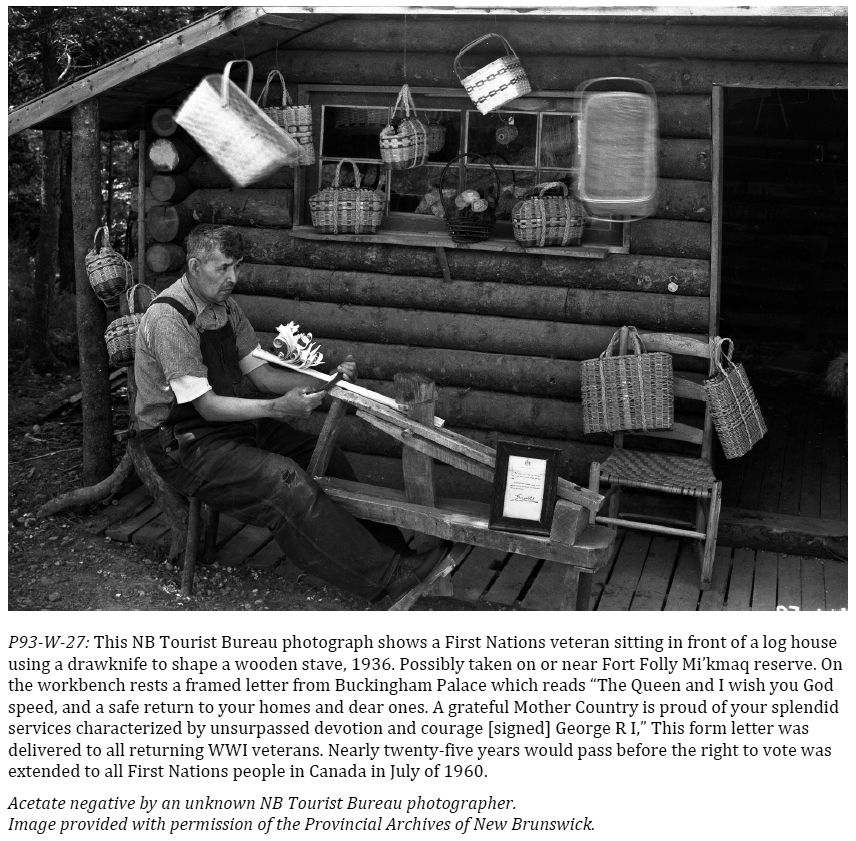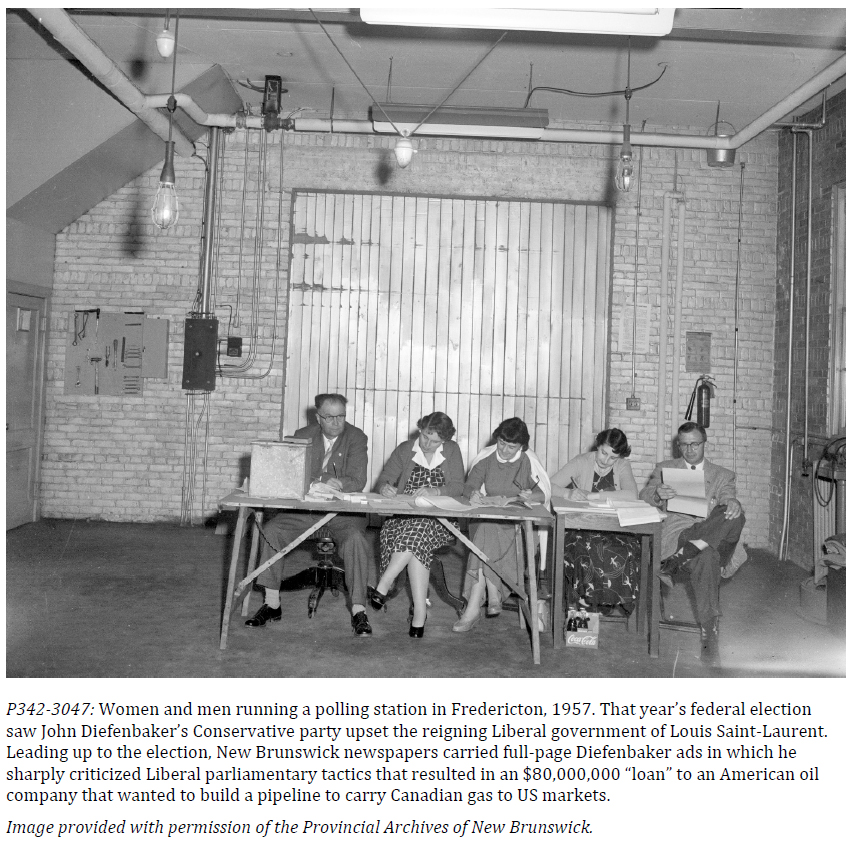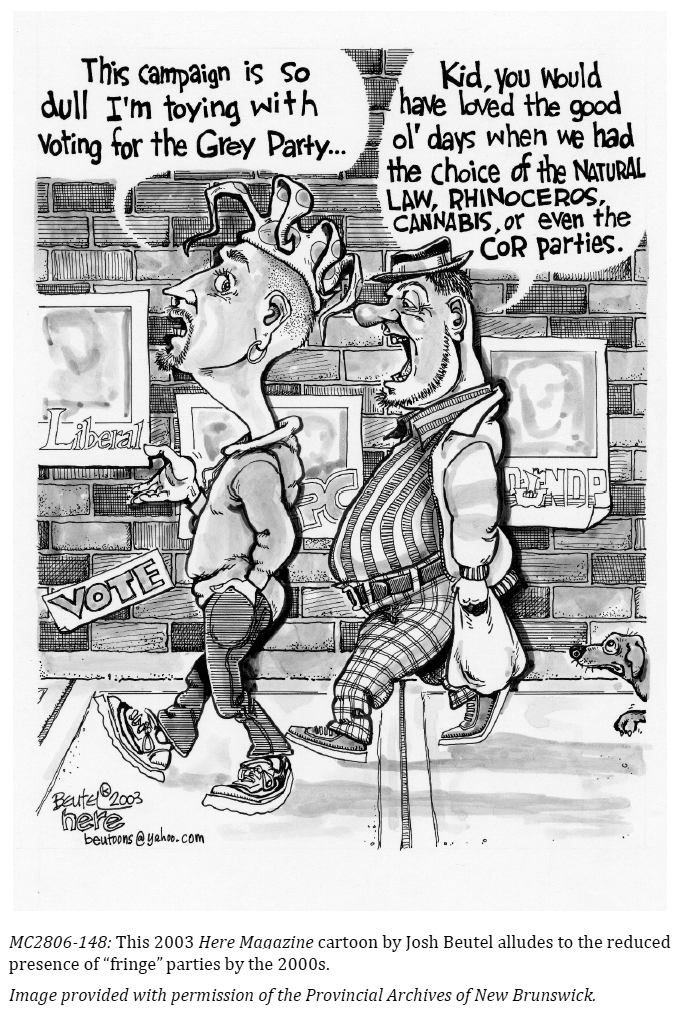Photo Essay
Images of New Brunswick’s Developing Electoral Maturity
P2-186: Old Government House, Fredericton, 1857.
In addition to being one of a series of three of the oldest known photographs of Fredericton, this image is of interest because one of the figures near the entrance is likely Lieutenant-Governor John Henry Thomas Manners-Sutton. After assuming his position in 1854, Manners-Sutton was authorized to make changes in colonial trade laws in compliance with the Legislative Council, and to bring the question of trade reciprocity with the USA before the provincial legislature. During the intervening years, the process of responsible government was firmly entrenched in the political system of the colony; the secret ballot was introduced; and the power of the (unelected) Legislative Council was reduced.
Albumen print attributed to George Stacy, a noted Civil War photographer.
Image provided with permission of the Provincial Archives of New Brunswick.
Image provided with permission of the Provincial Archives of New Brunswick.
P3-27: Last session of the Legislative Council of NB, 7 April 1892.
Last session of the Legislative Council of NB, 7 April 1892, in which the council abolished itself. The Legislative Council of NB was the upper house of the government of New Brunswick between 1785 and 1891, with members being appointed by the NB Lieutenant-Governor. After 1892, members of the Legislative Assembly were elected, not appointed.
Mounted albumen print by an unknown photographer.
Image provided with permission of the Provincial Archives of New Brunswick.
Image provided with permission of the Provincial Archives of New Brunswick.
P3-80: Studio portrait of the York County Council for 1906–1907.
Government based on the civil parish/county model had been established in New Brunswick in 1786 to counteract the influence of the republicanism emanating from the township-based American colonies. Separate from the members of the Legislative Assembly, counties, as municipal jurisdictions, were administered by a body of councilors who were elected by the freeholding citizens of the county. The County Warden acted as chief administrator for the Council, while the Secretary-Treasurer maintained the records, coordinated activities, and handled correspondence. During the nineteenth and twentieth centuries the provincial government expanded its role in these aspects of local life and county administration. In 1966, all county councils were abolished as part of the centralization program known as Equal Opportunity, instituted by the Liberal government of Premier Louis J. Robichaud. The (unsurprising) uniformity of the group is broken up by the presence of Miss A.O. Jackson, deputy secretary treasurer to secretary treasurer, F. St. John Bliss, seated just above her and to the left.
Mounted silver gelatin print George Burkhardt.
Image provided with permission of the Provincial Archives of New Brunswick.
Image provided with permission of the Provincial Archives of New Brunswick.
MC2806-130: Louis J. Robichaud dragging New Brunswickers through a door labeled “Equal Opportunity.”
This cartoon by Josh Beutel, which appeared in Here Magazine for 13 January 2005, speaks to persistent uncertainty among some New Brunswick residents about Robichaud’s Equal Opportunity reforms nearly forty years after the fact.
Image provided with permission of the Provincial Archives of New Brunswick.
P774-9 & P463-4: Gertrude Harding, 1889–1977.
(left) Studio portrait of Gertrude Harding as a young woman taken in Honolulu, Hawaii, c. 1912. Born in Welsford, NB in 1889, Harding travelled with her sister’s family to Hawaii and then to London where she joined the growing suffragette movement, eventually working on the underground newspaper, The Suffragette. New Brunswick women looked to British and western Canadian suffragist progress when calling for reform at home: the Daily Telegraph and Sun, a Saint John paper, reported on 1 March 1919 that a suffrage meeting in that city was headed by a Mrs. W.F. Hatheway. She was quoted as saying that “Quebec, New Brunswick and Prince Edward Island are the only provinces which regard their women as politically inferior to their men” and “she asked [that] the Saint John Local Council of Women … take some action toward influencing the New Brunswick legislature at its coming session to place its women on the same political basis as the other Canadian provinces had done, so that the province may be saved the disgrace of having to be forced to follow suit.”
Silver gelatin print by R.W. Perkins.
Image provided with permission of the Provincial Archives of New Brunswick.
Image provided with permission of the Provincial Archives of New Brunswick.
(right) Gertrude Harding of Welsford, New Brunswick (1889-1977) tries to sell the “Suffragette” newspaper (only permitted “off the curb”) to London bobbies policing the militant suffragette movement in 1913. The movement was led in part by sisters Emmeline, Christabel, and Sylvia Pankhurst under the banner of the Women's Social and Political Union in Great Britain during the years 1905–1914.
Silver gelatin DOP print by an unknown photographer.
Image provided with permission of the Provincial Archives of New Brunswick.
Image provided with permission of the Provincial Archives of New Brunswick.
P93-W-27: NB Tourist Bureau photograph, 1936.
This NB Tourist Bureau photograph shows a First Nations veteran sitting in front of a log house using a drawknife to shape a wooden stave, 1936. Possibly taken on or near Fort Folly Mi’kmaq reserve. On the workbench rests a framed letter from Buckingham Palace which reads “The Queen and I wish you God speed, and a safe return to your homes and dear ones. A grateful Mother Country is proud of your splendid services characterized by unsurpassed devotion and courage [signed] George R I,” This form letter was delivered to all returning WWI veterans. Nearly twenty-five years would pass before the right to vote was extended to all First Nations people in Canada in July of 1960.
Acetate negative by an unknown NB Tourist Bureau photographer.
Image provided with permission of the Provincial Archives of New Brunswick.
Image provided with permission of the Provincial Archives of New Brunswick.
MC2806-115: Public cynicism towards Bernard Lord’s plan to study democratic reform.
This 2004 Here Magazine political cartoon by Josh Beutel highlights public cynicism towards then-premier Bernard Lord’s plan to study democratic reform. In December 2003, the Lord Conservative government established a provincial Commission on Legislative Democracy, which sought public input on electoral reform. The Telegraph-Journal for 31 July 2004 ran one of a series of articles on public support for such reform. However, the same issue carried a statement from the deputy minister in charge of the aforementioned commission, David McLaughlin, which aptly summarized the public’s wariness of politicians, even when they purport to be interested in fairer representation: “People are cynical about institutions, they’re cynical about motives of politicians … you find there is quite a common sense of disaffection with politics and the political process, and at the same time, a common concern we can’t let this go on.”
Image provided with permission of the Provincial Archives of New Brunswick.
P342-3047: Women and men running a polling station in Fredericton, 1957.
That year’s federal election saw John Diefenbaker’s Conservative party upset the reigning Liberal government of Louis Saint-Laurent. Leading up to the election, New Brunswick newspapers carried full-page Diefenbaker ads in which he sharply criticized Liberal parliamentary tactics that resulted in an $80,000,000 “loan” to an American oil company that wanted to build a pipeline to carry Canadian gas to US markets.
Image provided with permission of the Provincial Archives of New Brunswick.
P342-4277-1: An elderly woman casts her vote at a polling station, c. 1960.
An elderly woman casts her vote at a polling station, likely in York County, c. 1960. Given the fact that enfranchisement wasn’t in force for New Brunswick women until 1919, this woman likely recalled the time when she was barred from participating in the democratic process on account of her gender.
Acetate negative by newspaper photographer Joe Stone, Sr.
Image provided with permission of the Provincial Archives of New Brunswick.
Image provided with permission of the Provincial Archives of New Brunswick.
P342-7368: Student protest, c. 1968–1969.
Student protest, possibly at College de Bathurst/Bathurst College, protesting high tuition fees, c. 1968–1969. Examples of protest messages visible are “Double the Grants,” “Freeze the Hike,” “Freeze Fees Tax Irving More,” and “Let Louis J. [Robichaud] Pay.” Judging from some of the other signs that read “March with Moncton” and “U de M Marche sur Moncton,” this demonstration may have been held in solidarity with the Université de Moncton protests of 1968–1969, which sought, in part, greater support for French-language service and equality in the province.
Acetate negative by newspaper photographer, Joe Stone, Sr.
Image provided with permission of the Provincial Archives of New Brunswick.
Image provided with permission of the Provincial Archives of New Brunswick.
MC2806-148: Reduced presence of “fringe” parties.
This 2003 Here Magazine cartoon by Josh Beutel alludes to the reduced presence of “fringe” parties by the 2000s.
Image provided with permission of the Provincial Archives of New Brunswick.
To comment on this article, please write to jnbs@stu.ca or consult our Facebook page at https://www.facebook.com/jnbsrenb. Si vous souhaitez réagir à cet article,veuillez soit nous écrire à jnbs@stu.ca, soit consulter notre page Facebook à https://www.facebook.com/jnbsrenb.
Joshua Green is the Photo Archivist at the Provincial Archives of New Brunswick.
